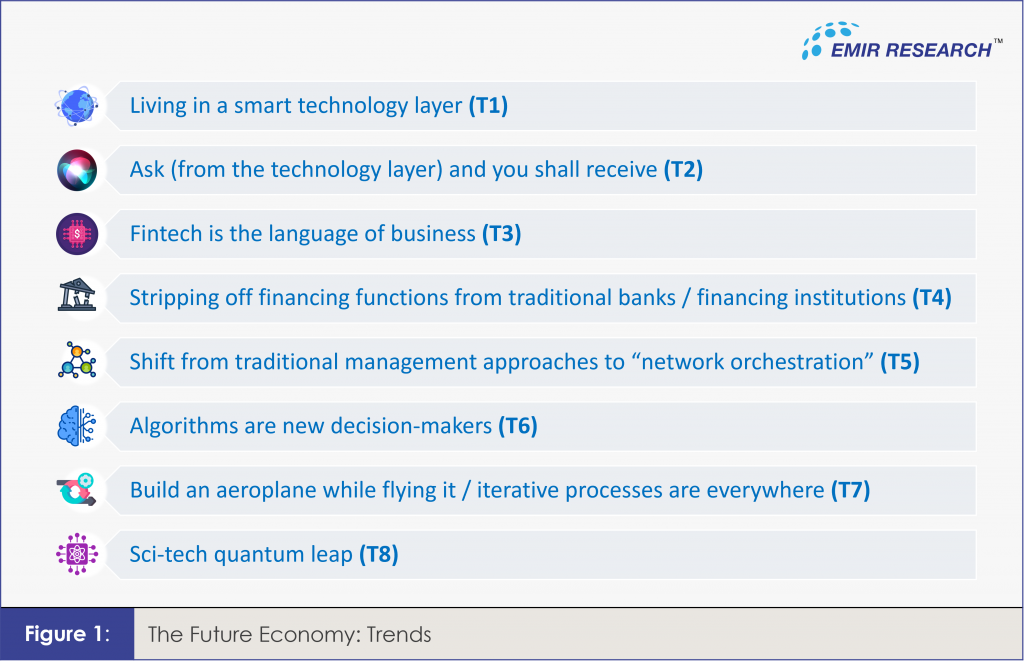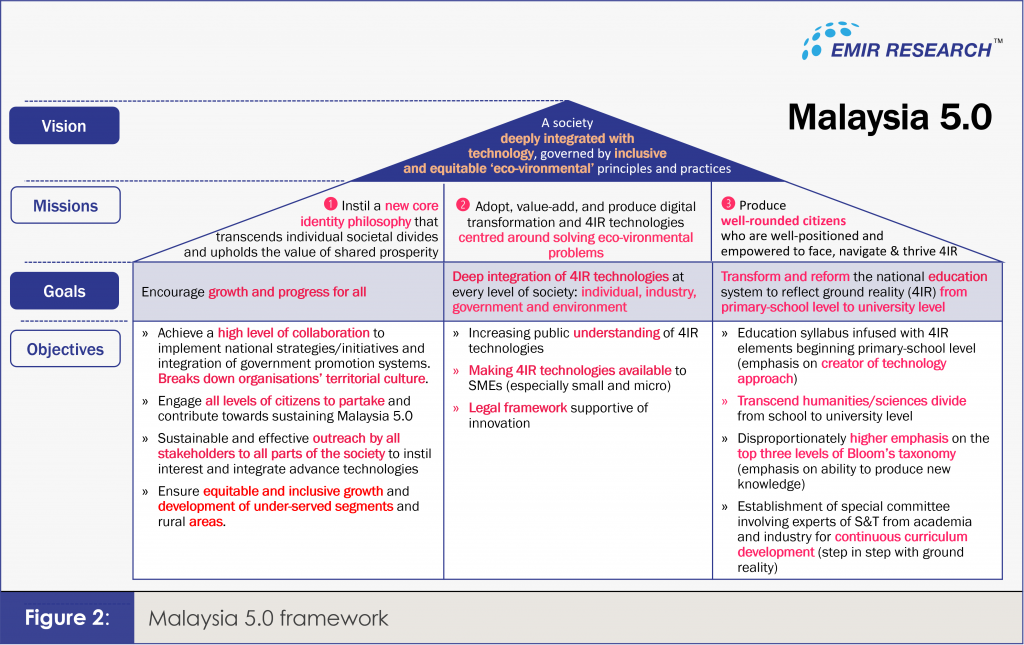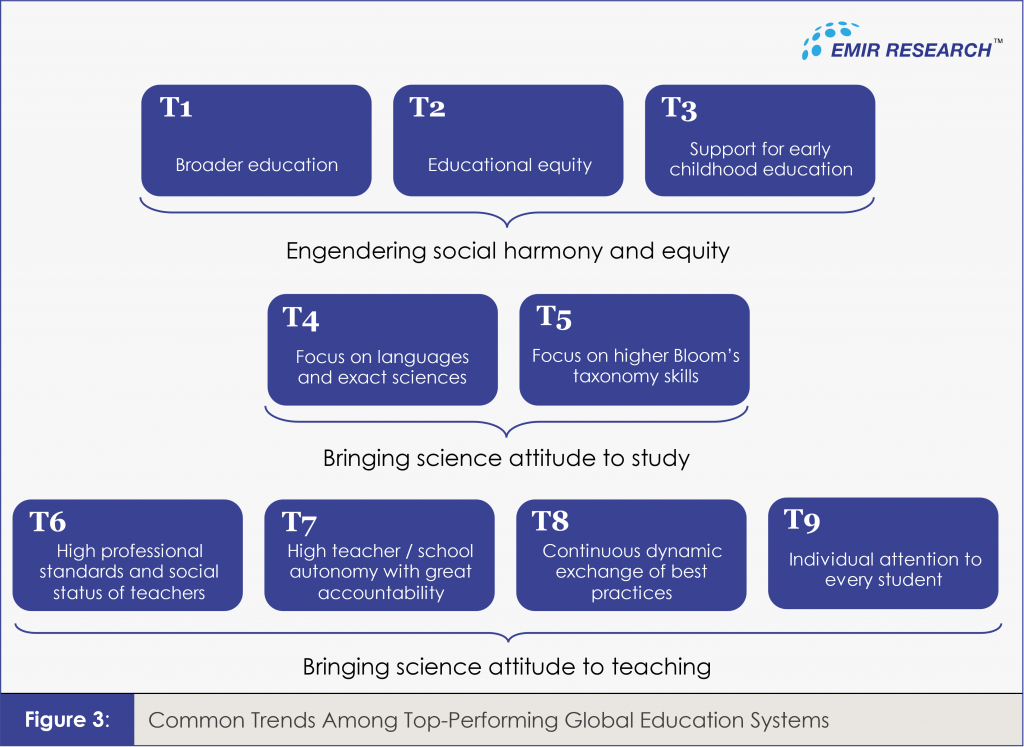
Published in AstroAwani, image by AstroAwani.
The “Future Economy” is no longer a distant concept; it is our present reality. Major trends have given rise to a new techno-social paradigm, presenting serious challenges to our education system in its current form (Figure 1).
Despite these trends evolving since 2016 (or even as early as 1995), the Malaysian education system remains inadequately prepared to navigate this rapidly changing landscape.

1. Living in a smart technology layer
Since 2016, the global socio-economy has been driven by widespread cyber-physical systems, known as the Fourth Industrial Revolution (4IR). These systems autonomously collect unbiased data through sensors, analyse patterns, find solutions, and apply them to the physical world with minimal human intervention. Combined, they create a metaphorical but very real “smart technology layer” that surrounds and traces all the contours of the real world.
Here are three important points to consider:
1) The technology layer is already here, profoundly influencing our lives.
2) This technology layer interacts with us continuously, not just on a request basis. It is aware of and reactive to our behaviour 24/7/365.
3) This technology layer belongs to individual tech giants (aggregators) who thrive on collecting and monetizing information about everyone.
Therefore, we need to build our own, sovereign, technology layer in Malaysia to ensure that its power is geared toward our nation’s benefits.
2. Ask (from the technology layer) and you shall receive
Living within the technology layer has shifted consumer behaviour towards an ‘ask, and you shall receive (immediately)’ mentality. This shift is evident across all age groups but is most pronounced among the youth. We use smartphones for everything from hailing rides to ordering meals and shopping on the go. This instant gratification mindset is increasingly prevalent, especially among younger generations.
This mindset, however, is extremely detrimental in educational settings. Students are less inclined to spend time synthesising information from various sources, missing opportunities for new knowledge creation. Instead, they opt for immediate knowledge reproduction. They even often bypass suggested reading links in favour of directly accessing images on Google! This trend illustrates how our immersion in the technology layer severely undermines the reading culture.
There’s an urgent need to understand how this immersion alters students’ cognitive behaviour. We must adapt our methodologies to nurture creativity in these new realities!
3. Fintech is the language of business
Before the 4IR, finance was the language of business. After 4IR, fintech redefined this by digitizing more and more things of value, putting them on the network, and moving them innovatively, thereby reinventing business models and processes—a phenomenon known as digital transformation. Today, much sought-after competitive advantage hinges on this very ability to digitise value, network it, and innovate business models and processes.
4. Stripping off financing functions from traditional banks and financial institutions
In 1994, Bill Gates predicted, “Banking will be necessary, banks are not”. Today, we are living this reality. Financing utility is now offered ubiquitously and seamlessly within the technology layer. “Shop now, pay later” is just one example of such ubiquitous integration.
These changes will likely impact other industries as well, as the best ideas and examples often come from outside one’s sector. Therefore, ongoing digital innovations and transformations in banking can provide valuable lessons for other industries.
Despite these profound changes, we continue to prepare traditional bankers and economists en masse, with only some knowledge of fintech. However, we need to cultivate well-rounded, organically tech-savvy individuals prepared to work across various industries, as fintech spans multiple sectors and is already ubiquitous.
Addressing this will also require tackling the brain drain issue, as more versatile human capital can lead to increased brain drain.
How do we produce well-rounded citizens who are empowered to face, navigate, and thrive in the 4IR? There is an urgent need to transform and reform the national education system from primary school to university level to reflect the reality of the 4IR aligned with the broader transformation of the economy under the Malaysia 5.0 umbrella (Figure 2), and, as a minimum:
- Infuse the education syllabus with 4IR elements starting at the primary school level, emphasizing a creator-of-technology approach.
- Transcend the humanities/sciences divide from school to university level.
- Place a disproportionately higher emphasis on the top three levels of Bloom’s taxonomy, focusing on the ability to produce new knowledge—an especially challenging task in the era of generative AI.
- Establish a special committee involving S&T experts from academia and industry for continuous curriculum development, ensuring it remains in step with current realities.

At the same time, our education system must be aligned with the global best practices (Figure 3).

5. Shift from traditional management to “network orchestration”
Networks and communities are crucial for contemporary digital entrepreneurs. The digital economy has given rise to the sharing economy, revealing countless unlocked resources and values. Platforms using sophisticated matching algorithms, connected devices, and AI-driven data analysis generate enormous business value. They disintermediate powerful entities, empower the underserved, and collectively unlock the value of underutilized resources.
This brings us to the concepts of digitisation, digitalisation, and digital transformation. Digitalisation involves using digitisation (turning facts and events into 0s and 1s) and digital technologies primarily for streamlining, profit maximization, and efficiency, while digital transformation is achieved when 4IR technologies are utilised to their maximum potential to reinvent the ecosystem.
Digital transformation is synonymous with a “first-principle design approach”, unlike the design-by-analogy method used in plain digitalisation. The first-principle design approach breaks a system or model into its core components (and functionality) and reassembles it in a revolutionary new way using cutting-edge science and technology. At this stage, businesses and entities crafting their 4IR strategies begin asking important questions such as:
- Does this use of technology create unique value for society as a whole?
- Does it liberate individuals in any way?
- Does it provide equal opportunities to all stakeholders?
- Does it help solve pressing socioeconomic and environmental problems?
By adopting the “first-principle design approach”, we are more likely to foster human transformation characterized by increased empathy, kindness, and generosity towards the entire ecosystem. This is the approach we need to embrace and emphasize in our educational methods!
6. Algorithms are new decision-makers
Decisions are made based on compilations of what customers generate, rather than by the CEO or top manager. AI can analyse nuanced patterns in human behaviour or other processes by classifying and clustering, although it may not provide detailed reasoning behind the process.
Therefore, there is an urgent need to cultivate essential skills for effective collaboration with AI, including a deep understanding of AI tools’ capabilities and limitations, thus allowing future professionals in many fields to discern when to rely on AI-generated insights and when to apply their professional judgment.
This effort must be contextualized within a comprehensive national AI strategy, as seen in innovative nations like Canada, China, Great Britain, Singapore, South Korea, the United States, and the United Arab Emirates.
Moreover, if research propels national progress, then current research methodologies require widely taught programming skills. This includes a thorough understanding of AI and its various branches, along with crucial aspects of ethics and governance associated with such systems.
7. Build an airplane while flying it or iterative processes are everywhere
The editable, re-combinable, re-programmable, and generative nature of digital technologies enables fluid and dynamic processes, encouraging fast iterations and non-linear paths in the business processes.
High-velocity leadership demands a focus on swift discovery—embracing incremental, immersive, and high-speed approaches that introduce novelty in small increments rather than relying solely on planned design.
Do we adequately instill these iterative approaches in our students? Are our teaching methodologies sufficiently iterative themselves?
How often do we encourage students to openly acknowledge their challenges in front of the class, rather than aiming for a polished, textbook solution to a given business case study? Real-life problems often lack clear parameters, given data, and experimenting is a must to uncover and address them.
Teaching methodologies that discourage transparency about difficulties, hinder opportunities for constructive feedback and improvement, and foster a competitive rather than collaborative learning environment undermine innovation at its core.
8. Sci-tech quantum leap
Quantum physics laws suggest not only a significant leap in communication efficiency and computational power but also a profound transformation in how and through which we communicate. This breakthrough greatly extends the scope of measurable phenomena, hinting at possibilities beyond the physical realm.
Quantum tech (QT) demonstrates its prowess in various business tasks, including complex pattern recognition (deep machine learning), modeling, optimization, simulation, and prediction for the behaviour of complex systems and processes, such as molecular systems, natural phenomena, chemical reactions, and other physical processes.
To meet this demand, we’ll need a significant number of QT specialists. It’s crucial to acknowledge that retraining an ordinary software engineer to program quantum algorithms isn’t straightforward. These specialists will need a thorough understanding of high-level mathematics and physics, as required by quantum physics. Are we adequately prepared to cultivate such well-rounded specialists?
In conclusion, navigating the terrain of the Future Economy demands a fundamental reshaping of Malaysia’s educational system. Only by doing so urgently can we empower our students to thrive in the ever-changing landscape of the digital age and position Malaysia for success in the global economy.
Dr Rais Hussin is the Founder of EMIR Research, a think tank focused on strategic policy recommendations based on rigorous research.

